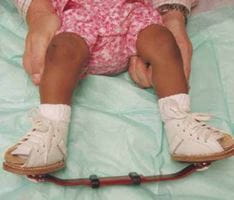Club Foot Treatment

Clubfoot (Talipes Equinovarus) is the most common deformity of the bones and joints in the feet of newborns, affecting 1 in 1,000 babies. Clubfeet are of unknown origin and occur in otherwise healthy infants. Treatment is successful as long as it is started early. The well-treated clubfoot is not a handicap and is fully compatible with an unhindered, active life.
Treatment
Typically, clubfeet can be corrected in six to eight weeks with a treatment called the Ponseti technique, which involves manipulations and application of plaster casts. Treatment should begin within the two weeks of life to take advantage of the elasticity of the tissues. Using plaster casts, the foot will be gently manipulated to stretch the ligaments and tendons on the inside, back and bottom of the foot. A new cast will be applied every week.
In most cases, the Achilles tendon will need to be completely divided in order to complete the correction of the deformity. The tendon will regenerate to the proper length to allow complete correction of the foot by the time the last cast is removed. In order to prevent relapse, your child will be prescribed a brace. This brace consists of “reverse last” shoes with a Denis Browne bar, which holds the feet pointing outward. The shoes must be worn full time until your child is 11 months old.
After that, your child will need to wear the shoes only at night until he/she is three years old. It is very important to always use the brace, otherwise recurrence of the clubfoot deformity will almost always occur. Use of the brace will not delay the child’s development in sitting, crawling or walking. The goal of treatment is to reduce or eliminate all of the components of the deformity so the child will have a functional, mobile, pain-free foot.
Helpful Tips for Wearing the Brace
- Expect your child to fuss for the first couple of days when in the brace. This is not because the brace is hurting him/her, but because it is something new and different.
- Play with your child in the brace to help him/her get used to not being able to move his/her legs independently.
- Gently push/pull on the bar of the brace to teach your child to flex and extend his/her knees.
- If you notice any red spots or blisters on your child’s feet, call the orthotist to see if modification is necessary.
For more information, call Children's Orthopedics of Tampa Bay at St. Joseph's Children's Hospital at (813) 554-8983.
